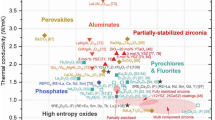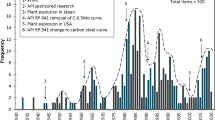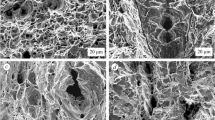Conclusions
It is shown that the hydrogen cold working effects and hydrogen plastification can take place in testing materials in hydrogen- and hydrogen sulfide-bearing media. However, these effects are unstable with time and are detected under specific conditions. They were detected if the surface of the tested specimen was smooth, without notches, cracks, large scratches, and the surface roughness was minimum.
These effects were not detected in the steel specimens with the coatings. In the aqueous solutions of H2S and H2S+ HCl hydrogen cold working was detected whereas in halide-bearing media it was not found.
The effects were detected in limited ranges of the mechanical loading rate. They cannot by utilized to increase the stress corrosion cracking resistance. The Soviet literature contains reports [15, 23, 24] according to which these phenomena in various processing treatments.
Similar content being viewed by others
Literature cited
E. A. Savchenkov, R. R. Aitkulov, and M. Sh. Nasredinov, “Effect of post-weld treatment of pipes of 20 steel on the resistance to hydrogen and sulfide corrosion cracking,” in: Express Information “Corrosion protection of environment,” No. 4, 3–5 (1987).
V. N. Polyakov, “Prospects of using pore-free aluminum coatings with high resistance to sulfide cracking in gas industry,” in: Review Information, Serious Corrosion and Corrosion Protection of Installations in Gas Industry [in Russian], No. 4, All-Union Scientific Research Institute of Economic Investigations, Gas Industry, Moscow (1988).
V. A. Gol'tsov, “The phenomenon of controlled hydrogen-phase cold working of metals and alloys,” in: Properties of Structural Metals under the Effect of Working Media [in Russian], Naukova Dumka, kiev (1980).
E. A. Savchenkov and R. R. Aitkulov, “Resistance of steel against hydrogen-strain effects,” in: Proceedings of 3rd Law-Seminar on Hydrogen in Metals [in Russian], Donetsk (1982), pp. 90–92, 289–290.
E. A. Savchenkov, “Failure resistance of steel in hydrogen charging in hydrogen sulfide,” Metalloved. Term. Obrab. Met., No. 8, 7–11 (1985).
E. A. Savchenkov and A. F. Svetlichkin, “Failure of steel in different stages of hydrogen embrittlement,” Metalloved. Term. Obrab. Met., No. 12, 19–21 (1980).
E. A. Savchenkov and R. R. Aitkulov, “Hydrogen-strain hardening and softening of steel at different temperatures and loading modes,” in: Collection of Scientific Works on Corrosion and Protection of Metals [in Russian], No. 6, Kaliningid (1983), pp. 29–41.
A. F. Svetlichkin, G. F. Raizman, and O. M. Babushkina, “Embrittlement of steel in interaction with the hydrogen sulfide-bearing medium,” in: Nauchn. Tr. VNIPIgaza Corrosion Protection of Equipment [in Russian], Baku (1983), pp. 74–82.
V. N. Geminov, V. G. Pronyuk, G. P. Makarov, et al., “Examination of the effect of hydrogen-containing components on the mechanical characteristics of high-strength steels,” Express Information: Corrosion and Corrosion Protection of Welds, pipelines, Equipment, and Sea Installations in Gas Industry, No. 5 (1986), pp. 18–19.
V. N. Geminov, V. N. Polyakov, V. G. Pronyuk, et al., “Examination of the corrosion resistance of D16T aluminum alloy,” Express Information: Corrosion and Corrosion Protection of Welds, Pipelines, Equipment, and Sea Installations in Gas Industry, No. 6 (1985), pp. 31–33.
V. N. Polyakov, N. I. Igaev, and E. P. Anan'ev, “Effect of the process of deposition of a coating on the properties of the parent metal,” Express Information: Corrosion and Corrosion Protection of Welds, Pipelines, Equipment, and Sea Installations in Gas Industry, No. 2 (1987), pp. 31–39.
R. A. Oriani and P. H. Josephic, “Effects on the plastic properties of medium-carbon steels,” Met. Trans. Ser. A, No. 11, 1809–1820 (1980).
R. A. Oriani, “Hydrogen effects of steels,” Mater. Sci.,8, 327–340 (1978).
T. Tabata and H. H. Birnbaum, “Direct observations of the behavior of dislocations in iron,” Ser. Met.,17, 947–950 (1983).
V. H. Nosov and B. A. Kolachev, Hydrogen Plastification in Hot Deformation of Titanium Alloys [in Russian], Metallurgiya, Moscow (1986).
V. I. Savenko and E. D. Shchukin, “Residual stresses formed in materials deformed in surface-active media by bending,” Poverkhn. Fiz.-Khim. Mekh., No. 12, 20–25 (1987).
V. N. Polyakov, “Evaluation of the mechanical properties of D16T aluminum alloy in hydrogen sulfide-bearing media,” Express Information: Petrochemical Construction, Corrosion, and Protection of Environment, No. 1 (1979), pp. 7–9.
V. N. Polyakov, V. P. Karshin, V. N. Geminov, and L. K. Gordienko, “Protective properties of composites (steel-powder aluminum coating) produced by compacting electrophoretic and electrostatic deposits,” Fiz.-Khim. Mekh. Mater., No. 1, 104–109 (1986).
V. N. Polyakov, “Using protective coatings for equipment in gas industry,” in: Review Information, Serious Development and Service of Gas and Gas Condensate Deposits [in Russian], All-Union Scientific Research Institute of Economic Investigations in Gas Industry, No. 8, Moscow (1986).
V. N. Polyakov, “Possibilities of using the method of ‘hydrogen treatment’ (hydrogen cold working) in gas-processing plants and other industrial installations of the Ministry of Gas Industry, “Analytical Report to Ministry of Gas Industry [in Russian], All-Union Scientific Research Institute of Economic Investigations in Gas Industry, Moscow (1986).
P. Huwart, M. Habashi, and J. Galland, “Proprieties mechaniques et cinetiques du fussiration par fatigue d'aciers inoxydables,” Mem. Etudes Sci. Rev. Metall, Mars., 139–152 (1987).
E. M. Gutman, Mechanochemistry of Metals and Corrosion Protection [in Russian], Metallurgiya, Moscow (1981).
“A method of increasing the durability of cutting tools,” Information Letter on Scientific and Technical Achievements, No.87-045, Center for Scientific and Technical Information, Odessa (1987).
Yu. L. Dilonoga and Ya. M. Sirak, “Effect of hydrogen charging the counter surface on fretting fatigue of metal,” Fiz.Khim. Mekh. Mater., No. 4, 108–110 (1987).
Author information
Authors and Affiliations
Additional information
Translated from Fiziko-Khimicheskaya Mekhanika Materialov, Vol. 26, No. 4, pp. 50–54, July–August, 1990.
Rights and permissions
About this article
Cite this article
Polyakov, V.N., Geminov, V.N., Kushnarenko, V.M. et al. Possibilities of utilizing cold working caused by hydrogen in practice. Mater Sci 26, 421–425 (1991). https://doi.org/10.1007/BF00727056
Received:
Issue Date:
DOI: https://doi.org/10.1007/BF00727056




